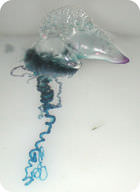捷克人
Section outline
-
Are corals animal , plant, or mineral ?
::珊瑚是动物、植物还是矿物?Some corals may look like rocks. But they are alive! And some corals may look like plants, but they are actually animals. Just like all other animals, they eat food to get energy .
::有些珊瑚可能看起来像岩石,但它们是活的。有些珊瑚可能看起来像植物,但实际上它们是动物。就像其他动物一样,它们吃食物以获得能量。Cnidarians
::捷克人Cnidarians , in the phylum Cnidaria , include organisms such as the jellyfish , corals, and sea anemones. These animals are found in shallow ocean water. You might know that these animals can give you a painful sting if you step on them. That’s because cnidarians have stinging cells known as nematocysts . Cnidarians use nematocysts to catch their food. When touched, the nematocysts release a thread of poison that can be used to paralyze prey . Cnidarians are among the simplest of the so-called "higher" organisms, but are also among the most beautiful.
::辛达里人(Cnidarians)的植物包括水母、珊瑚和海葵等生物。这些动物在浅水中被发现。你也许知道这些动物在踩上它们时会给你带来痛苦的刺痛。这是因为辛达里人有叫Nematocysts的刺细胞。 辛达里人使用纳托细胞来捕捉它们的食物。 被触摸后,内虫会释放出一串毒气,用来麻痹猎物。 辛达里人是最简单的所谓“ 高” 生物之一,但也是最美丽的生物之一。Body plan
::机构计划The body plan of cnidarians is unique because these organisms show radial symmetry , making these animals very different from those that evolved before them. Radial symmetry means that they have a circular body plan, and any cut through the center of the animal leaves two equal halves.
::辛迪亚人的身体图案是独一无二的,因为这些生物表现出了辐射对称性,使这些动物与以前进化的动物大不相同。 辐射对称性意味着它们有一个圆形身体图案,任何切穿动物中心的任何切开都会留下两等分之二。The cnidarians have two basic body forms:
::童子军有两种基本身体形式:-
Polyp
: The polyp is a cup-shaped body with the mouth facing upward, such as a sea anemone and coral.
::聚苯乙烯:聚苯乙烯是一种杯状的身体,嘴朝上,如海葵和珊瑚。 -
Medusa
: The medusa is a bell-shaped body with the mouth and tentacles facing downward, such as a jellyfish.
::Medusa:Medusa是一个钟形的身体,嘴部和触角朝下向下,如水母。
Unlike the which evolved prior to cnidarians, the cnidarians are made up of true tissues . The inside of a cnidarian is called the gastrovascular cavity , a large space that helps the organism digest and move nutrients around the body. The cnidarians also have nerve tissue organized into a net-like structure, known as a nerve-net, with connected nerve cells dispersed throughout the body. Cnidarians do not have true organs , however.
::与尼达里人之前的进化不同,尼达里人是由真实的组织组成的。 尼达里人内部被称为胃血管洞,这是一个大的空间,可以帮助生物体消化和在身体周围移动营养物质。 尼达里人还有神经组织组织,形成一个被称为神经网的网状结构,将神经细胞连接到全身。 但是,尼达里人没有真正的器官。is by asexual budding (polyps) or sexual formation of gametes (medusae, some polyps). The result of sexual reproduction is a larva , which can swim on its own.
::性繁殖的结果是幼虫,可以自己游泳。Cnidarian Colonies
::殖民殖民地Some types of cnidarians are also known to form colonies. Two examples are described below.
::据了解,一些类型的童子军也构成殖民地,下面列举两个例子。-
The Portuguese Man o' War (
Figure
) looks like a single organism but is actually a colony of polyps. One polyp is filled with air to help the colony float, while several feeding polyps hang below with tentacles. The tentacles are full of nematocysts. The Portuguese Man o' War is known to cause extremely painful stings to swimmers and surfers who accidentally brush up against it in the water.
::葡萄牙人战争(Figure ) 看起来像一个单一的有机体,但实际上是聚虫的殖民地。 一种聚虫充斥着空气来帮助聚虫漂浮,而一些喂养聚虫则用触手挂在下面。 触角里充满了纳马托细胞。 葡萄牙人战争已知会给游泳者和冲浪者造成极其痛苦的刺痛,他们不小心在水中冲浪。
The Portuguese Man o' War can deliver nasty stings with its tentacles.
::葡萄牙人战争能用触角 带来下流的刺痛-
Coral reefs
(
Figure
) look like big rocks, but they are actually alive. They are built from cnidarians called corals. The corals are
sessile
(non-moving) polyps that can use their tentacles to feed on ocean creatures that pass by. Their skeletons are made up of
calcium
carbonate, which is also known as limestone. Over long periods of time, their skeletons build on each other to produce large structures known as coral reefs. Coral reefs are important
habitats
for many different types of ocean life.
::珊瑚礁(图)看上去像大岩石,但实际上它们都是活的。它们是由被称为珊瑚的珊瑚礁建造的。珊瑚是悬浮(非移动)的聚虫,可以用它们的触角喂养经过的海洋生物。它们的骨骼由碳酸钙组成,也称为石灰岩。在很长一段时间内,它们的骨骼相互依存,形成被称为珊瑚礁的大型结构。珊瑚礁是许多不同种类海洋生物的重要栖息地。
Corals are colonial cnidarians.
::珊瑚是殖民的童子军。Summary
::摘要-
Cnidarians have radial symmetry and true tissues.
::克尼达里亚人有辐射对称性和真实的组织。 -
Some cnidarians form colonies, such as corals.
::一些尼达人形成殖民地,如珊瑚。
Explore More
::探索更多Use the resource below to answer the questions that follow.
::利用以下资源回答以下问题。Explore More I
::探索更多-
Cnidarians: Life on the Move
at
(14:44)
::辛达里人:移动中的生活(14:44)
-
How do cnidarians move?
::尼达人如何移动? -
Why was movement a useful innovation for cnidarians?
::为何运动对尼达人来说是有用的创新? -
What is a nematocyst? For what purpose(s) are they used?
::神经细胞是什么?它们用于什么目的? -
What allowed cnidarians to swim the world's oceans?
::是什么让尼达里人游过世界的海洋?
Explore More II
::探索更多情况二-
Cnidarians: Moon Jelly Life Cycle
at
(3:15)
::辛达里亚人:月球果冻生命周期(3:15)
-
How do polyps differ from medusas?
::聚氨酯与甲草胺有何不同? -
Describe the mating of moon jellies.
::描述月球果冻的交配情况。
Review
::回顾-
What are three examples of cnidarians?
::汉人的三个例子是什么? -
What is an nematocyst? What does it do?
::什么是神经细胞? -
Distinguish between the two body plans of a cnidarian.
::区分一个皇室的两套计划 -
How is a jellyfish different from a Portuguese Man o’ War?
::水母与葡萄牙人战争有何不同?
-
Polyp
: The polyp is a cup-shaped body with the mouth facing upward, such as a sea anemone and coral.

